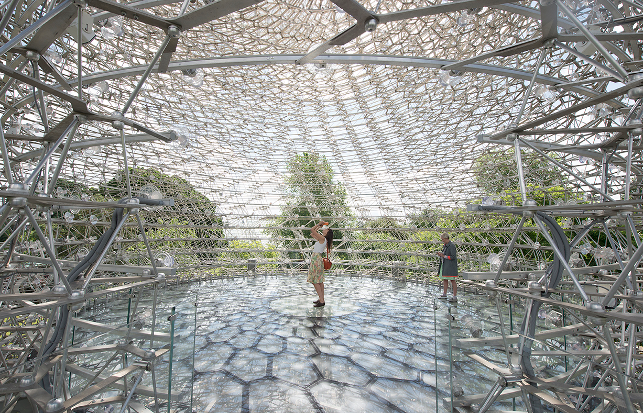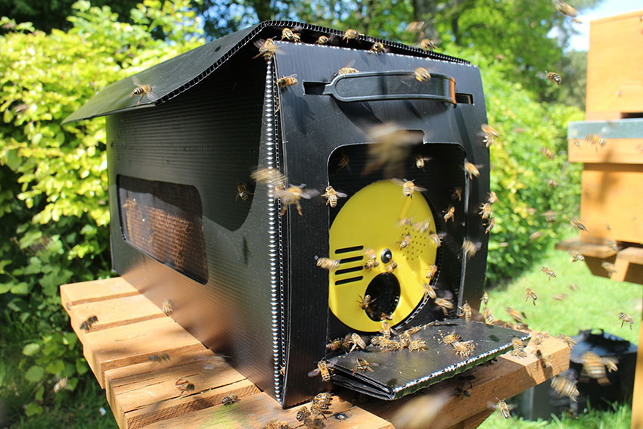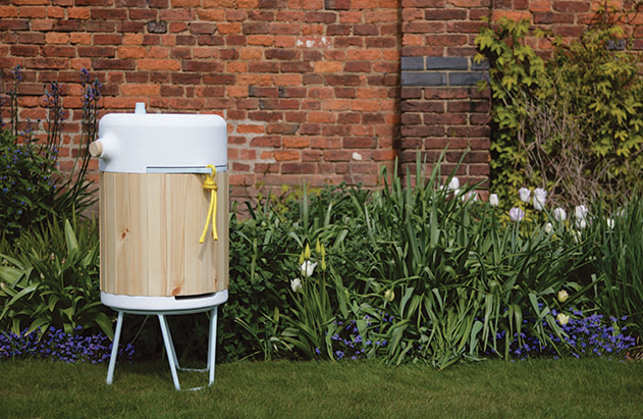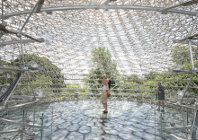
What’s the buzz
This first hive is actually not a beehive at all in that it doesn’t house a colony of bees. Rather it’s a large-scale sculpture inspired by scientific research into the health of bees.
Located in The Royal Botanical Gardens at Kew in London this 17-metre high aluminium abstractive ‘honey comb’ provides visitors with a unique experience with its hundreds of LED lights within the central void that glow and fade as they respond to the activity of bees via accelerometers within a (real) beehive at Kew .
Designed by UK-based artist Wolfgang Buttress, it was originally created as the centre piece of the UK Pavilion at the 2015 Milan Universal Exposition under the theme ‘Feeding the Planet, Energy for Life’ for which it received a coveted gold medal.
Buttress’ rather ambitious design, which compromised 169,300 individual components, involved a multi-disciplinary project team of which Stage One was the main contractor.
No stranger to large-scale projects this North-Yorkshire based design and engineering company with its 8,000m2 facility has worked on a wide variety of projects from automation packages for West End shows and rollercoaster rides, to Heatherwick Studio’s London 2012 Olympic cauldron.
Despite its vast experience, Tim Leigh, Stage One’s sales and marketing director, says that this was one of the most complex and intricate things that the company had ever been commissioned to create.
“For us, the process of making involved over 4,500 CAD hours to develop workshop drawings before machining, finishing and packaging each component in specific batches, each item etched with its own reference number for ease of construction.
“The manufacturing processes kept our machine shop occupied for more than 16 hours a day for five months with each component being made in such a way that it could be bolted together on-site and built up layer-by-layer as a kit of parts,” describes Leigh.
The complete Hive structure weighs approximately 50 tonnes and rests on a concrete pad foundation. 18 steel columns are bolted to this pad and support a 10.8 metre steel ring beam.
“Whilst the aesthetic and form is critical in communicating the notion that this is a beehive, the chords and rods of the structure have each been optimised through careful parametric analysis to ensure that the Hive is not only decorative but also structurally sound and bears its own weight. This means that the sculpture is eff ectively a giant truss,” adds Leigh.
Stage One recently moved the structure from the Expo site to Kew. The move involved a systemic de-rig, site specific modifications and additions to the structure, along with ground reinforcement and all groundworks.
Having opened in June 2016, this is one hive worth a visit and thankfully one where you won’t have to wear protective clothing.

The bee’s knees
What the general public don’t understand about swarming bees is that they are pretty docile. In a bid to reproduce, they have split from their colony and are on a mission to find a new home.
The new foldable Bait Hive concept from University of Brighton product design graduate, Josh Akhtar, is dedicated to attracting them.
“My father has kept bees for seven years and makes wooden boxes for use as lures to collect feral swarms of bees. I decided to make up some of these swarm boxes and they then became the focus of my studies.”
He started out the project by doing research with both the public and beekeepers. “My initial sketch of Bait Hive started as an origami sphere. I then began making models by hand, before mocking up something more serious in CAD. I used kasemake – a fantastic, no nonsense bit of kit for packaging design.”
The final design is made from 6mm thick fluted black plastic board (Correx) and high density expanded polyethylene foam, which will be press cut. The resulting hive is light, hard wearing, waterproof and insulated.
Akhtar is currently looking at how best to manufacture his design and is planning a crowdfunding campaign in the next few months. I, for one, am very excited about this product!

Bee aware
Loughborough University Industrial Design and Technology graduate Elspeth MacLeod wants to entice the younger generation into beekeeping with her self-monitoring urban beehive, Mella, with onboard temperature and humidity sensors that are connected to a smartphone app.
MacLeod was inspired to design a beehive having been a beekeeper herself for the past five years alongside her dad.
“I was looking at some of the issues we had with traditional beehives, and trying to work out how we could be keeping bees differently. I also wanted to try look at a slightly different approach, where there was less focus on honey collection, and more focus on the welfare of the colony.”
She started off the 9 month design process with research noting down ideas and making quick sketches along the way.
“As the design became more refined, I started to create models in Creo Parametric. This was a great tool for visualising the designs, and helped me to experiment with size, form, materials, and colours,” she says.
MacLeod took her final product, which is made of UV stabilised polyethylene, to the graduate design show New Designers this summer and not only received the runner up prize but was pleasantly surprised by the interest the hive received.
A look at the latest products inspired by our furry flying friends
Default






